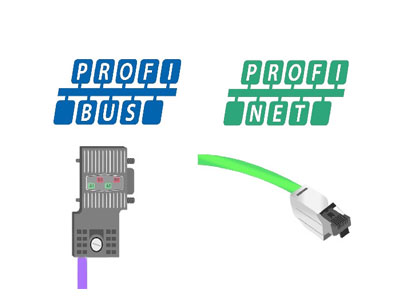Key Takeaway
No, PROFINET and PROFIBUS are not the same. PROFIBUS is a fieldbus protocol that uses serial communication to connect devices like sensors and actuators. It’s reliable and commonly used for simple, real-time control in smaller systems. However, it operates at slower speeds compared to modern Ethernet-based protocols.
PROFINET, on the other hand, is an industrial Ethernet protocol designed for high-speed communication. It supports real-time and deterministic data transfer, making it ideal for complex automation systems like robotics and motion control. While both are developed by the same organization (PI), PROFINET is more advanced and offers better scalability, flexibility, and performance for larger industrial networks.
Introduction to PROFINET: The Ethernet-Based Successor to PROFIBUS
PROFINET and PROFIBUS both originate from Siemens and are widely used in industrial communication systems. However, they are fundamentally different. PROFIBUS, short for Process Field Bus, is a serial communication protocol introduced in the late 1980s. It was designed to connect PLCs with field devices like sensors and actuators efficiently.
PROFINET, on the other hand, is the newer Ethernet-based successor to PROFIBUS. Introduced in the 2000s, PROFINET builds on Ethernet technology, enabling faster and more reliable communication. Unlike PROFIBUS, which uses serial communication, PROFINET operates over Ethernet, allowing it to integrate seamlessly with modern IT networks.
To sum it up:
PROFIBUS is a robust serial protocol suitable for older systems.
PROFINET leverages Ethernet for high-speed, real-time communication and better scalability.
Understanding this distinction is critical, as both protocols have their strengths depending on the application.

The Ethernet-Based Successor to PROFIBUS H2: Key Differences Between Serial PROFIBUS and Ethernet-Based PROFINET
The primary difference between PROFIBUS and PROFINET lies in their communication technologies. Here’s a breakdown:
Communication Medium:
PROFIBUS uses serial communication, which is slower but reliable for older systems.
PROFINET uses Ethernet, offering higher speeds and better bandwidth for real-time data exchange.
Data Transmission Speed:
PROFIBUS supports speeds up to 12 Mbps.
PROFINET can achieve speeds up to 100 Mbps or more, crucial for applications like motion control.
Topology Flexibility:
PROFIBUS typically uses bus or tree topologies, which can be limiting in complex systems.
PROFINET supports flexible topologies, including star, line, and ring configurations.
Integration with IT Systems:
PROFIBUS operates in isolated industrial networks.
PROFINET bridges industrial and IT networks, making it ideal for Industry 4.0 applications.
While PROFIBUS remains reliable for legacy systems, PROFINET is the preferred choice for future-proof industrial automation.
Key Differences Between Serial PROFIBUS and Ethernet-Based PROFINET H2: ApplicationsWhere PROFIBUS Still Excels
Key Differences Between Serial PROFIBUS and Ethernet-Based PROFINET
H2: ApplicationsWhere PROFIBUS Still Excels
ApplicationsWhere PROFIBUS Still Excels H2: Advantages of PROFINET in Modern Industrial Automation
PROFINET has quickly become the go-to protocol for modern industrial automation, and for good reasons:
High-Speed Communication: PROFINET’s Ethernet foundation allows real-time data transfer, critical for applications like robotics and motion control.
Scalability: Whether you’re automating a small process or an entire factory, PROFINET can scale effortlessly, accommodating thousands of devices in a single network.
Integration with IoT and Industry 4.0: As industries embrace smart manufacturing, PROFINET’s ability to integrate with IT systems and cloud platforms makes it indispensable.
Advanced Diagnostics: PROFINET offers built-in diagnostic tools that make it easier to identify and resolve issues, reducing downtime and maintenance costs.
Flexibility: With support for various topologies and redundancy options, PROFINET ensures seamless communication even in complex setups.
For example, an automotive assembly line that uses robotic arms, conveyor systems, and inspection cameras can benefit from PROFINET’s speed and reliability. It ensures every device communicates in sync, enhancing productivity and reducing errors.
Advantages of PROFINET in Modern Industrial Automation H2: Transitioning From PROFIBUS to PROFINET for Future-Proofing
Transitioning from PROFIBUS to PROFINET is an essential step for industries looking to modernize their automation systems. Here’s how you can make the switch effectively:
Assess Your Current System: Evaluate whether your existing PROFIBUS infrastructure meets your operational needs. If you’re facing limitations in speed, scalability, or integration, it’s time to consider PROFINET.
Plan Gradual Upgrades: Transitioning doesn’t mean replacing everything at once. Many hybrid solutions allow PROFIBUS and PROFINET to coexist, enabling a phased upgrade.
Invest in Training: Engineers familiar with PROFIBUS may need training to understand PROFINET’s capabilities and implementation. This ensures a smoother transition.
Leverage Gateways: Gateways allow PROFIBUS devices to connect to PROFINET networks, ensuring compatibility and extending the life of older equipment.
The transition might seem daunting, but it’s a worthwhile investment. PROFINET’s scalability, speed, and integration capabilities make it the ideal choice for industries aiming to stay competitive in the age of Industry 4.0.
Conclusion
While PROFINET and PROFIBUS share a common lineage, they are tailored for different eras of industrial automation. PROFIBUS excels in legacy systems and environments where rugged, dependable communication is sufficient. However, PROFINET is the protocol of the future, offering high-speed, scalable, and flexible solutions that align with modern automation demands.
For engineers, understanding when to use each protocol is critical. Whether you’re working with legacy systems or designing new ones, leveraging the strengths of PROFINET and PROFIBUS can optimize your industrial network and pave the way for future advancements.
